One-year anniversary of CC move marks the beginning of another change
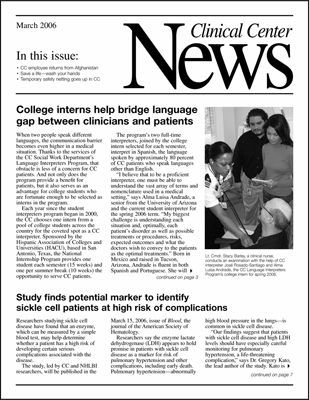 |
Look for the new print design for CC News.
|
April 2, 2006, marks the one-year anniversary of the hospital's move from the Clinical Center's Magnuson building to the new Hatfield Center. That Saturday morning, the building was filled with a nervous energy as staff and volunteers rushed to polish that last inch of flooring or unlock that first door.
But anxiety and nervousness disappeared in an instant-the moment the first pediatric patient, sitting up on his bed, was wheeled from the old building, through the atrium and to the entrance of the new pediatric unit. He was greeted with cheers as everyone celebrated not just his arrival, but also the arrival of something bigger—something many had waited and labored over for years—the official opening of the Hatfield Clinical Research Center.
Now, one year later, we have settled into our spaces, learned most of the hallways and decided on our favorite coffee drink at the atrium cafe. The space doesn't feel quite as new to us anymore, but I like to think back on what this building must have looked like to that first patient. As he traveled from the familiar hallways of the old building and came into that light-filled atrium with a ceiling that seemed to stretch on forever, what must it have felt like to see the building for the first time? Judging from the look in his eyes, it was an impressive sight. It certainly was for me.
In honor of this one-year landmark, we felt it was fitting to celebrate another change-one that goes hand in hand with the new building. The CC News print newsletter has maintained its same design for more than a decade. It seems appropriate that a newsletter for CC employees should reflect the very space in which we work. So, with special thanks to Bryan Ewsichek in the ORS Division of Medical Arts and Printing Services for his graphic expertise, we present the new CC News design.
Designed to have an architectural feel like the new building itself, the new print layout is meant to generate the same open, breathing space as the Hatfield Center. Photo captions are constructed in a grid-like pattern to reflect the clean lines of the building, the pages' white space gives the layout an airy feel, and the newsletter's typeface matches the signage throughout the building. Because the intention was to update the old design rather than completely overhaul it, you will still see elements of the old design, presented in a refined final product.
In a CC News survey that many of you responded to a few months ago, you shared feedback that was very helpful in the redesign process. One of the common requests for a CC News change was to shift to a color publication. While the print version must remain black and white for economic reasons, you can view it in full color by visiting CC News online at this site through the intranet.
I hope you enjoy the new design.
—Katie Boswell
Back to Top
National Volunteers Week honors
special helpers at the Clinical Center
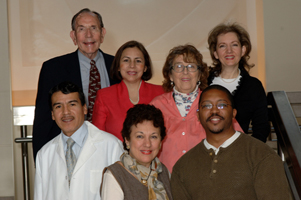 |
As part of National Volunteers Week, the Clinical Center celebrates the more than 200 volunteers currently working here including (back row, l to r) Dr. Joe Held, Patricia Cosgrove, Betty Sanders, Fay Darya, (front row) Dr. Franz Jemio, Dalia Isicoff and Michael Harris-Love.
|
Joining the scores of CC employees who endeavor each day to bring healing and comfort to patients are about 200 volunteers. This mighty force includes people serving in the Red Cross, the animal therapy program, the family friend program and as language interpreters, just to name a few. Each year, the CC Social Work Department honors these special individuals as a part of National Volunteers Week, which is April 23-29 and includes an awards ceremony on April 28.
"So often people think our volunteers are motivated solely by altruism," says Andrea Rander, director of volunteer services in the Social Work Department. "But there are those who are trying on a new career for size or retirees who have always volunteered and want to continue to do so after retirement. Regardless of their motivation, these volunteers all have very special hearts and I have a great respect for each of them."
Fay Darya is one of the CC language interpreters and one of only two who speak the Persian language, Farsi. She came to the United States from Iran in 1982 with her husband and 14-month old daughter, leaving a country that, at the time, was immersed in revolution. "We were doing our best to meet the demands of our time," she says. Luckily, because her husband, Saeed, had been studying in New York, the family was granted visas so he could complete his education in the U.S. The Daryas, along with their daughter Sheri and son Sepehr, who was born in the U.S., have lived here ever since.
Darya's relationship with NIH began in 1996 when she volunteered for one year at NIMH prior to beginning a master's program in rehabilitation counseling. After she completed her master's program and began studying for a doctorate, she contacted Andrea Rander in the Social Work Department and was signed up to serve as a volunteer in the Language Interpreters Program.
"Thanks to people like Fay, we have interpreters who can translate languages from A to Z, Arabic to
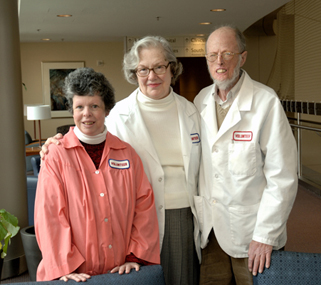 |
The Canter family, (left to right) Susan, Floride and Harry, have a combined total of 53 years spent working as Red Cross volunteers at the Clinical Center.
|
Zulu, and every letter in between." Rander says.
"I like to hear people's stories," says Darya, who is a professional counselor. "I have learned so much by helping patients. Being with a patient and going through a difficult time with them is a very moving experience."
When she receives a call asking for her interpretation services, Darya will often read up on the patient's condition and medications, researching as much as she can so she will be prepared to help the patients and doctors communicate with one another clearly and efficiently.
"It is not just about the language," she adds. "Patients need someone to talk to, someone who will understand them-their background, culture or religious beliefs-in addition to their medical condition."
Darya says the patients and the staff are what inspire her to continue volunteering, in spite of her busy academic and professional schedule. "Many patients who come here are willing to try experimental drugs not because it might help them, but also because other people might benefit. Likewise, the NIH staff do a wonderful job working with these patients under difficult circumstances. It takes a lot of courage and commitment from both sides."
Among the other volunteer programs at the CC is the American Red Cross. Many of the Red Cross volunteers have been offering hugs, smiles and cookies to CC patients for decades. It is a legacy of dedicated service that Floride Canter takes very seriously. As chairwoman of the Red Cross, Canter has worked at the CC for about 25 years.
Because families can wait hours to find out the results of a loved one's surgery or test results, they are often reluctant to leave the waiting area. Through this anxious time, the Red Cross' simple act of bringing snacks or coffee becomes especially meaningful to those individuals. Each morning Canter serves a continental breakfast to the phlebotomy patients and brings around the daily coffee and cookie cart to the clinics. Though she jokes that she is not sure what the families are more pleased to see—her or the cookies—their smiles show appreciation for both.
Canter's husband, Harry, and their daughter Susan volunteer in the Red Cross as well. A 13-year volunteer, Harry worked at NIH for 43 years before retiring as chief of the research, analysis and evaluation branch of the Division of Extramural Activities at NCI. Susan has volunteered at NIH for about 15 years.
"People thought I was crazy to keep working," says Harry. "But it is more soothing to sit down and help others."
While each of the Canters will humbly list their responsibilities as mail delivery or bringing library books to units, their roles clearly mean more to the people they serve. The Canters are able to provide many patients with the one thing they are often most in need of—a family.
Floride tells the story of a young man who was preparing to go in for a treatment. "He said to me, 'you remind me so much of my grandmother,'" she says. He then asked her for a hug. "If hugging him made it easier for his treatment, then it is worth being called a grandmother," Floride says with a smile as she wipes away her tears.
"The Red Cross volunteers provide so many services," says Rander. "They even maintain a clothing closet for those patients who are in need of clothes."
From the Red Cross to the interpreters program, the volunteers tend to CC patients as if they were personal friends or family. They serve as a patient's voice when language barriers become an obstacle, they provide food when someone is hungry, and they bring friendship and comfort to patients who just need a hand to hold or a friend to talk to.
"I hope NIH continues to appreciate the worth of these volunteers," says Rander. "Those who choose to volunteer at NIH are special people, and they are here serving equally special people—our patients."
—By Kathryn Boswell
Back to Top
Pharmacy employees receive CC's Patient Safety Champion Award
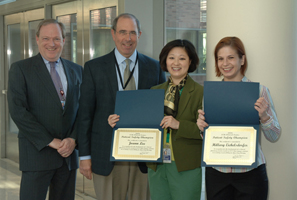 |
From left to right: Andrew Wilson, pharmacy chief, John I. Gallin, CC director, and award winners JoAnn Lee and Hilary Eichelsdorfer of the CC Pharmacy Department.
|
When their supervisor, the head of the pharmacy department and a group of other smiling administrators holding balloons greeted pharmacy employees Drs. JoAnn Lee and Hilary Eichelsdorfer, they weren't sure what to make of the situation. Turns out, the group was there to surprise the two with the Clinical Center's Patient Safety Champion Award.
Now in its second year, the award is given annually to individuals or teams who demonstrate a sustained commitment to creating and maintaining a safe environment for patients. On March 7, Lee and Eichelsdorfer were honored at a casual ceremony where they were applauded by their colleagues and presented with certificates that read, "In recognition for development of a clinical pharmacy practice model on OP8 that engages patients in assuming responsibility for their drug therapy."
Lee's and Eichelsdorfer's responsibilities as pharmacists are somewhat unique because of their dedicated staff positions within the OP8 unit, where they counsel and distribute medications to HIV patients. As the clinical liaison, Lee splits her time between the outpatient pharmacy and the clinic, attending weekly meetings in the clinic to participate in the nurses' patient-issue discussions and working at the pharmacy window. Though she admits it is a challenge, Lee says she appreciates the dual responsibility because it allows her to get to know the individual patients and their conditions in addition to managing the drug order process.
Eichelsdorfer, in addition to her post as outpatient pharmacist, assumes Lee's duties when needed. She points out that the OP8 method of processing and filling medication requests has proved to be efficient and beneficial to the patients. Typically in a pharmacy, a physician will request a specific medication for a patient. The prescription is then printed in the pharmacy where a pharmacist checks the label and counsels the patient when needed. "In addition to that process," Eichelsdorfer explains, "we take an extra step. After the labels come off the printer, we will screen all of them to make sure they correspond with a patient's profile. This is where we are able to prevent errors right away."
This extra step is so successful in the OP8 environment because Lee and Eichelsdorfer have daily contact with the patients and nurses. Because they get to know the patients as individuals-learning the various details of their conditions, treatments and histories-they are better equipped to notice an error or inconsistency in their prescriptions. "HIV patients are on a complex drug regimen," Lee says. "By having a couple of pharmacists dedicated to this particular treatment, it means we are more familiar with the intricacies. Patients feel more comfortable knowing they are dealing with someone who knows their individual treatment program."
In his nomination letter, recommending Lee and Eichelsdorfer for the award, their supervisor Thomas Dorworth, chief, Pharmaceutical Procurement and Control Section, wrote, "In a disease state where medication compliance is critical, Drs. Lee and Eichelsdorfer's contributions to improved outcomes and enhanced patient safety through engaging patients to participate in their therapy is a great success."
"These patients are very knowledgeable," adds Eichelsdorfer. "They are interested in the medications as well as herbal treatments and want to know as much as we do. I find it challenging in a good way because you have to be on top of things."
But don't expect Lee or Eichelsdorfer to accept all the credit for the success of the OP8 pharmacy team. While their names may be the ones printed on the award certificates, they both point to their colleagues and supervisor as the winners too. "It is nice to be noted for something that all pharmacists do," Lee says. "I'm a very small part of the whole process. I don't think it is about me or about Hilary, it's about what pharmacists do and what they could be doing more of."
"Like every department and unit at the CC, there are a million things happening in the background that people don't see," Eichelsdorfer says. "People think pharmacists just count the pills, put them in the bottle and give them to the patient, but there is so much more. And everyone on our team has a hand in that."
Both Lee and Eichelsdorfer express special thanks to the pharmacy/OP8 section heads and the outpatient pharmacy staff for their support.
—By Kathryn Boswell
Back to Top
NCI researcher and founder of Astute Clinician Lecture Robert W. Miller passes away
Dr. Robert Warwick Miller, scientist emeritus at NCI and founder of the Astute Clinician Lecture series, died on February 23 at his home in Bethesda. He was 84 years old.
After receiving his M.D. from the University of Pennsylvania, Miller trained in pediatrics, radiation
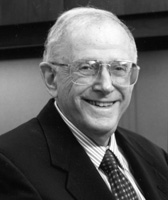 gt;<> gt;<> |
|
Dr. Robert W. Miller, scientist emeritus at NCI, passed away February 23.
|
medicine and epidemiology, earning a doctorate in public health at the University of Michigan. He joined NCI in 1961 as chief of the Epidemiology Branch, where he carried out pioneering research on childhood cancer. The relationships he discovered between birth defects and certain cancers-such as absent irises and Wilms' tumor of the kidney-provided important insights into the genetic and developmental mechanisms underpinning cancer. In 1994 he was named scientist emeritus and continued his research up until the last few weeks.
Before coming to NIH, Miller served in Hiroshima, Japan, as chief of pediatrics at the Atomic Bomb Casualty Commission. President Harry S. Truman established the agency after World War II to study the health effects of radiation among survivors of the atomic bombs. During this time, he observed that children exposed to the radiation while in their mothers' wombs were born with a higher frequency of certain birth defects.
Throughout a distinguished career spanning 45 years at NCI, Miller stressed the importance of alert clinical observations in providing initial clues to the causes of cancer, birth defects and other diseases, as well as the value of interdisciplinary approaches that integrate the epidemiologic, clinical and basic sciences.
As an extension of his research interests, Miller founded the Astute Clinician Lectureship, which is part of the NIH Director's Wednesday Afternoon Lecture series and coordinated by the NIH Clinical Center. The series specifically honors the path-breaking work of clinical scientists. Now in its ninth year, it was established through a gift from Miller and his wife, Haruko "Holly" Miller.
"Dr. Miller, himself an astute clinician, recognized that insightful clinical observations often lead to innovative research and medical breakthroughs," said Dr. John I. Gallin, CC director. "Because of the generous gift he and his wife made to NIH, scientists who exemplify this path to discovery give lectures here annually as a celebration of clinical research."
Miller is survived by his wife of 51 years who served as a research chemistry technician in NCI's Laboratory of Molecular Carcinogenesis for most of her 27 years at NIH.
A memorial service in honor of Miller will be held on April 29 at 1 p.m. at the Lipsett Amphitheater. For more information, please contact Mindy Kaufman at kaufmanm@mail.nih.gov.
Back to Top
In memoriam: Remembering Charley Carter
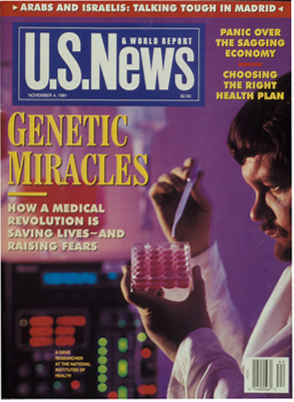 |
Charlie Carter appeared on the Nov. 1991 cover of U.S. News and World Report for his work with gene-corrected cells.
|
Charley Carter was a big man by almost any measure, and he cast a giant shadow. He was a wizard in the laboratory where he had an uncanny ability to commune with cells in culture and to solve the most vexing laboratory instrument problem. He was also an NIH "lifer," a teacher, leader, husband and father and a devotee of all Maryland sports. On March 27, Charles S. Carter, Jr., died unexpectedly while at home, watching the University of Maryland Lady Terps basketball team compete for a Final Four slot in the NCAA championship series. He was 52 years old.
Charles S. Carter, Jr., director of development in the Transfusion Medicine Department, was a lifelong Marylander. Born in Olney, he never ventured far from Rockville where he attended Rockville High School. He went on to earn a B.S. degree in microbiology at the University of Maryland. In 1978, he volunteered as a summer technician in what is now NIDCR, which ignited an enduring interest in medical research. The following year he joined the same institute as an entry-level technician in the laboratory of Dr. J.J. Oppenheim, where he learned rigorous laboratory techniques and a love of cell biology and clinical investigation.
In 1982, Carter joined the Clinical Center Blood Bank, now the Department of Transfusion Medicine, where spent the next 24 years. It was there that he later met his future wife, Laura, who was training as a specialist in medical technology. Carter was one of the original members of a small R&D team known as the Special Services Laboratory, which evolved over two decades into the Cell Processing Section. He helped to build this laboratory into a central resource for NIH intramural investigators and one of the world's leading facilities for preparing novel biologics for clinical trials.
In 1990, Carter was part of a small team that prepared the first therapeutic gene-corrected cells that were used to treat a child with severe combined immune deficiency disease, a feat that landed his picture on the November 1991 cover of U.S. News and World Report. Carter's special genius lay in devising innovative methods for preparing novel cellular components suitable for clinical trials protocols-everything from engineered stem cell grafts to dendritic cells and pancreatic islet cells. Most of these skills were self taught although he learned from-and improved upon-the work of numerous colleagues at NIH, in academia and in industry. They invariably became lifelong friends and debate opponents.
Carter believed passionately in quality management and customer service; his ultimate customer was the CC patient, but every investigator who had a need and every co-worker who had a problem was a customer deserving his full attention and energy. He was typically the first to volunteer and a long and tireless worker. Beneath his sometimes-brash veneer, new technologists found a patient teacher and mentor, and a tenacious problem-solver.
He was an inveterate fan of the Washington Redskins, the Baltimore Orioles and any University of Maryland athletic team. He was also a volunteer coach and a powerful cleanup hitter on a number of local softball teams.
He had unwavering loyalty to what he considered the best department in the finest hospital at the most important research institution in the world. His loyalty to NIH was exceeded only by his devotion to his family.
Carter authored or co-authored more than 75 original publications, most related to cell collection, culture, preservation or use in clinical research. But his influence extended far beyond his publications as he personally trained and educated a generation of technologists, scientists and regulators in good laboratory practices as applied to research biologics. He received numerous performance awards as well as the CC Director's Award and the NIH Director's Award. Perhaps his greatest honor remains the love and recognition of an extended family and a legion of friends and colleagues around the world.
He is survived by his wife, Laura; daughter, Katelyn; brothers, Earl and John; and mother, Marjorie.
—By Dr. Harvey G. Klein, Chief, Transfusion Medicine Department
Back to Top
Four-legged visitors provide Clinical Center patients with more than just smiles
Ten-year-old Ana Lucia Garcia has been looking forward to her visitor's arrival all day. As the door to her hospital room swings open, Garcia smiles and giggles from her bed as a bright-eyed, eager face enters the room. It's Ross-an Irish setter-on his regular visit to the pediatric unit.
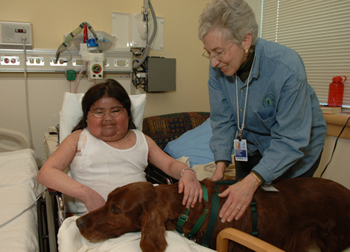 |
Pediatric patient Ana Lucia Garcia welcomes her four-legged visitor, Ross, and his handler National Capital Therapy Dogs volunteer Barbara Murgo. Ross and his other furry friends make regular visits to patients at the Clinical Center.
|
Ross is one of more than a dozen dogs that make visits to patients at the NIH Clinical Center. The recreation therapy section of the Rehabilitation Medicine Department started an animal-assisted therapy program in 1989. In the beginning, the dogs came once a month and only visited pediatric patients. Now the dogs come once a week and stop on units throughout the CC, averaging 1,200 visits per year.
Recreation therapist Holly Parker oversees the program and has been with it since it started. She says animal-assisted therapy is one of the most popular tools she and her colleagues use. "Animals provide a motivation that other tools can not," says Parker. "I think animals are a good motivator because they are alive. They give positive feedback to patients and a level of connection, care and tactile stimulation that other things don't give them."
"I like the lazy ones," says 13-year-old Mila Mathieu, describing the less rambunctious dogs. "They just lie down, and they're easier to pet." On this particular day, Mathieu is one of several children visiting with a therapy dog in the pediatric playroom, which is a regular stop for the dogs. He plays with a Cavachon named Sophie, whose owner has taught her a game to find a treat hidden under one of three small boxes. Even though Sophie seems to have the game down to a science, sniffing out the correct box every time, Mathieu is delighted each time the dog tosses the box aside with her nose.
Dogs like Sophie and Ross are canine volunteers with the nonprofit National Capital Therapy
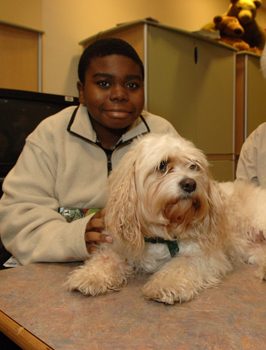 |
|
Mila Mathieu, a patient in the CC pediatric unit, likes Sophie (pictured above) because she is friendly and "easier to pet," he says.
|
Dogs, Inc. Their human counterparts bring the dogs to health care facilities throughout the Baltimore/Washington, D.C., area to provide animal-assisted activities and therapy. And both owner and pet are dedicated to their work. "Some volunteers drive an hour to and from their homes to bring their pets to the CC," notes Parker.
The owners say the rewards are well worth the effort. "I love working with my dog," says Barbara Murgo, who owns Ross. "You can see the good you do immediately. It's amazing how he brightens someone's day."
The owners must have their dogs certified as therapy dogs and must bathe them within 24 hours before each hospital visit. Their first stop at the CC is a checkup with veterinarian Lisa Portnoy. She gives them a full exam, nose-to-tail, before they have contact with patients.
The dogs and their handlers make either one-on-one or group visits, depending on each patient's mobility and the purpose of the therapy session. Parker says there are a number of ways dogs are used to help patients. "Walking down the hall with a dog can help someone recover from surgery," she gives as one example. "Brushing a dog and clipping or unclipping the leash can improve motor skills, or playing with a dog in a group setting can help improve social skills."
A number of studies have been done on the benefits of interacting with animals, including a recently started CC study. In this study, the CC's Pain and Palliative Care Service is examining whether animal-assisted therapy makes a difference in a cancer patient's pain, anxiety or discomfort. The study is currently recruiting adult cancer patients at the CC.
For information about participating in the study, contact Julie Hoehl at (301) 402-0272 or jhoehl@nih.gov.
—By Shana Potash
Back to Top
News briefs
Dr. Li invited to give Sosman lecture at Brigham and Women's Hospital
Dr. King Li, CC associate director for radiology and imaging sciences, was the keynote speaker for March's Merrill C. Sosman Lecture at the Brigham and Women's Hospital in Boston. The hospital—a 747-bed teaching affiliate of Harvard Medical School—chooses eminent physicians to present the annual Sosman lecture, which is named in honor of a former department chairman.
CC in the news
Washington Post, March 14, 2006—A study by Dr. Dave Wendler, Department of Clinical Bioethics, was featured in an article on the accuracy of surrogate decision makers. The article reads, "Findings suggest that today's system of decision making for incapacitated patients is in need of serious medical attention."
HealthDay news service—Dr. Gregory Kato, a clinician in the CC Department of Critical Care Medicine and director of the NHLBI Sickle Cell Vascular Disease Unit, was interviewed by HealthDay news service about a study that found a potential marker to identify sickle cell patients at high risk of complications. The HealthDay report was published and broadcast by numerous news organizations across the country.
Take Your Child to Work Day 2006
This year NIH celebrates its 12th annual Take Your Child to Work Day. On Thursday, April 27, from 9 a.m. to 4 p.m., the NIH institutes and centers will host educational and fun activities designed to let children (ages 8-15) experience the world of biomedical research and public service. Information on activities and registration requirements is online at http://takeyourchildtowork.nih.gov/. Program planners promise a day of fun, learning and career ideas for parents and their children. If you would like to sponsor an activity on Take Your Child to Work Day 2006, or for general information and to volunteer, please contact Gary M. Morin, committee chair, Voice (301) 496-4628, TTY (301) 480-3122 or moring@od.nih.gov. NIH employees will receive an e-mail this month announcing the opening of registration.
Dr. Neuhauser appointed committee chair of Society of Infectious Diseases Pharmacists
Dr. Melinda Neuhauser, clinical pharmacy specialist for NIAID, was appointed chair of the Professional Affairs/Public Policy Committee of the Society of Infectious Diseases Pharmacists (SIDP). In her role, Neuhauser will be responsible for keeping the society informed of policy changes at NIH, FDA, CDC and the Clinical and Laboratory Standards Institute as well as assisting the society president in efforts to educate the public on antimicrobial use and reducing resistance in hospitals. SIDP is an association of health professionals dedicated to promoting the appropriate use of antimicrobial agents. Its membership comprises pharmacists and other allied health-care professionals who are concerned with practicing, teaching and performing research in the area of infectious diseases.
Dr. Patricia Benner joins NIH celebration of National Nurses' Week as 2006 keynote speaker
This year's National Nurses' Week will be celebrated May 6-12 to honor the contributions and hard work of nurses. For this year's event, Dr. Patricia Benner, a nurse, nationally recognized authority on nursing issues and author of the book "From Novice to Expert," will serve as the keynote speaker. Benner is also a professor at the University of California, San Francisco. The NIH community is invited to attend this event, which will be held Tuesday, May 9, from 10 a.m. to 11:30 a.m., in Lipsett Amphitheater.
Pharmacotherapy Frontiers symposium
The Pharmacotherapy Frontiers symposium will be held Saturday, April 22, in the Masur Auditorium. The annual symposium, which was first offered by the CC Pharmacy Department in 1995, is designed to share cutting-edge drug therapy issues with the pharmaceutical community. Initially speakers were chosen only from the Pharmacy Department, but as interest in the program grew, NIH researchers as well as FDA administrators were invited to volunteer their time and share their expertise. The seminar is funded by the Clinical Center, with no cost to attend. The seminar topics are suitable for nurses, health-care professionals and non-professionals interested in new and exciting drug therapy. The CC pharmacy is an approved provider of continuing pharmaceutical education. Online registration opened on March 21, with attendance limited to the first 500 attendees. Announcements and registrations for future symposia will be made through e-mail and online at www.cc.nih.gov/phar.
Back to Top
CC staff say, "Yes, I washed my hands!"
On March 13, Maria Gebey (pictured far right) and Angela Michelin from CC Epidemiology Service delivered baskets with candy to the patient care units along with the popular "Ask me if I've washed my hands!" buttons for staff to wear. The buttons are part of the Clinical Center's celebration of Patient Safety Week. This year's theme is hand hygiene.
For more information on hand washing and hygiene, contact the Hospital Epidemiology Service at (301) 496-2209.
Back to Top
Upcoming Events
April 12 (Wednesday)
Noon–1 p.m. Lipsett Amphitheater
Contemporary Clinical Medicine: Great Teachers <
Grand Rounds: Alzheimer’s Disease
Steven T. DeKosky, MD, Professor and Chair, Department of Neurology, University of Pittsburgh
April 12 (Wednesday)
3 p.m. Masur Auditorium
NIH Director's Lecture
Richard Frackowiak, MD, Professor, Institute of Neurology, University College, London
April 19 (Wednesday)
Noon–1 p.m. Lipsett Amphitheater
Grand Rounds: Kidney Cancer: At Long Last Chemotherapy is Beginning to Make a Difference
Tito Fojo, MD., PhD, Head, Experimental Therapeutics Section, Medical Oncology Branch, CCR, NCI
Inflammatory Breast Cancer: Biology and Treatment
Sandra Swain, MD, Head, Breast Cancer Section, Medical Oncology Branch, CCR, NCI
April 19 (Wednesday)
3 p.m. Masur Auditorium
NIH Director's Lecture
Michel Nussenzweig, MD, PhD, Sherman Fairchild Professor, HHMI Investigator and Senior Physician, Rockefeller University.
April 22 (Saturday)
7:30 a.m.-3 p.m. Masur Auditorium
Pharmacotherapy Frontiers Symposium
For more information, visit www.cc.nih.gov/phar.
April 26 (Wednesday)
Noon-1 p.m. Lipsett Amphitheater
Grand Rounds: Influenza 2006—Preparing for the Pandemic
David K. Henderson, MD, Deputy Director for Clinical Care, CC
Interhemispheric Interactions in Motor Control of a Paretic Hand After Stroke
Leonardo G. Cohen, MD, Chief, Human Cortical Physiology Section and Stroke
Neurorehabilitation Clinic, NINDS
April 26 (Wednesday)
3 p.m. Masur Auditorium
NIH Director's Lecture
Thomas Pollard, MD, Chair, Department of Molecular, Cellular and Developmental Biology, Yale University
April 27 (Thursday)
9 a.m.-4 p.m. NIH Campus
12th Annual Take Your Child to Work Day
For more information, contact Gary Morin at Voice (301) 496-4628, TTY (301) 480
3122 or moring@od.nih.gov.
May 9 (Tuesday)
10 a.m.-11:30 a.m. Lipsett Amphitheater
National Nurses' Week Awards Ceremony
Patricia Benner, RN, PhD, Professor, School of Nursing, University of California, San Francisco
To view other NIH and Clinical Center events, click here.
|
|
Clinical Center News, National
Institutes of Health, Building 10, 10 Center Drive, Room 12C440, Bethesda, MD 20892-1504. Tel: 301-496-6787.
Fax: 301-402-2984. Published monthly for CC employees
by the Office of Communications, Patient Recruitment, and Public Liaison. News, article ideas,
calendar events, letters, and photographs are welcome.
Back to Top
|
|


 The information on this page is archived and provided for reference purposes only.
The information on this page is archived and provided for reference purposes only.